File check
Configuring a File check
Executing a File check
File check results
A set of substances can be checked via the File check where a single file containing all the substances is filtered for controlled substances.
Click ![]() to open File check page. The Uploaded files panel lists all previous file checks of the logged-in user.
to open File check page. The Uploaded files panel lists all previous file checks of the logged-in user.
The details of the user's earlier file checks are displayed in the Summary drop-down when clicked on a row. Even a new report can be generated from that File check from this drop-down.
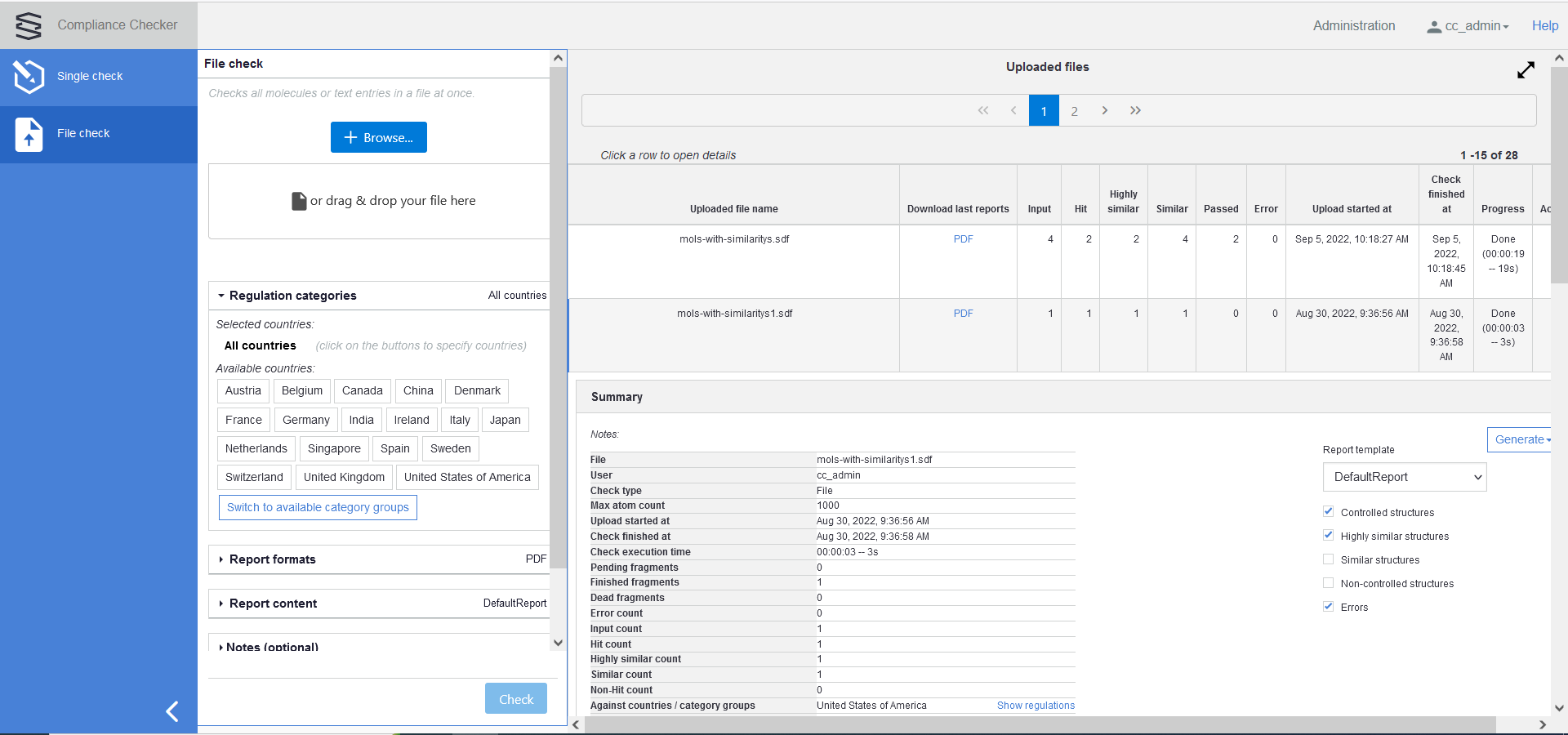
Configuring a File check
Choose file
In order to upload the file to be checked, drag&drop a file or click on the Browse button. A regular file open window will be displayed.
If the service is down or the file is bigger then the size set in the application property an error message is displayed.
File check of chemical structure files
A large selection of industrially acknowledged standard chemical file formats is supported e.g. SDF, MRV, SMILES, MOL, and even (IUPAC or traditional) names to name a few. The complete list of supported file formats can be found here.
File check of CSV files
CSV files containing chemical structures in one-row format (MDL MOL, SMILES, SMARTS, names, CAS Registry Number®, InChI e.t.c.) can be file checked.
The file requires comma-separated values and needs to have CSV extension.
After selecting a CSV file the mandatory Specify structure column dropdown appears in a red box below the filename. The drop-down lists the first line items and the user must select the column that contains the structure. The Check button is inactive until the structure column is not selected.
Below this drop-down, there is the No header checkbox which needs to be checked if the first row contains a structure to be checked.
Other columns of the CSV file will be available in the Report template together, as Input data fields.
If the selected Report template contains the ID field and the file contains properties of the structures then the user is forced to select a property as the ID field.
The Check button is inactive until the ID field is not selected.
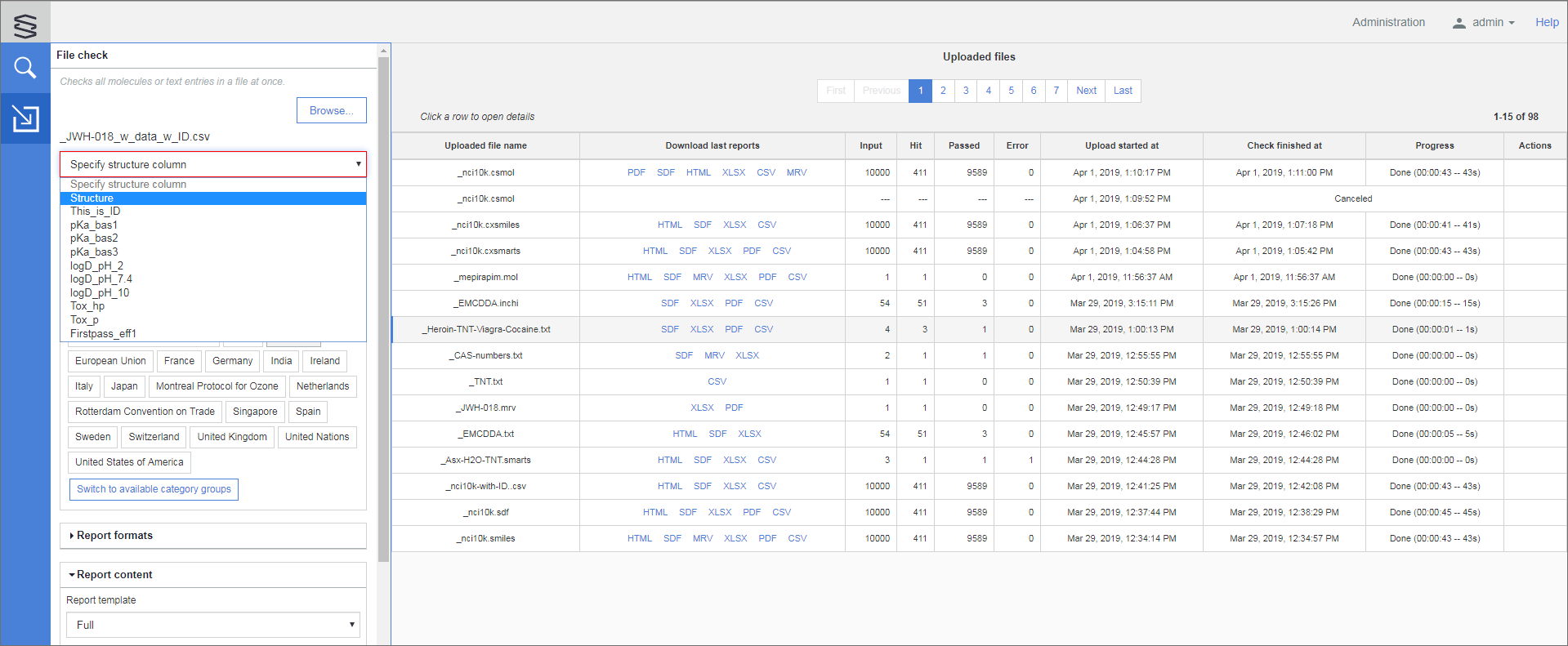
If the CSV file - especially the structure column - contains an error then the File check fails with the Error during structure import message.
Regulation categories
Regulation categories are the unique regulations, the legislation of a country, or an international organization/association like the European Union or the United Nations.
Category examples:
- AT Suchtgiftverordnung Anhang I
- CH Swiss Controlled Substances Act (BetmVV-EDI) Narcotics List A
- EU REGULATION (EC) No 273/2004 OF THE EUROPEAN PARLIAMENT AND OF THE COUNCIL of 11 February 2004 on drug precursors ANNEX I
- United Nations Single Convention on Narcotic Drugs 1961 Schedule I
Grouping of these categories serves to make easier to select regulations against which the actual compliance checking will be run.
We provide a built-in grouping of the categories from the point of view of the countries, besides this grouping, the possibility to create user-defined category groups is also supported. User-defined category groups are called category groups.
Countries are built-in category groups in Compliance Checker and cannot be modified by the user.
Each country as a category group consists of the followings:
- legislation of the given country with their national regulations.
- legislation of international organizations/associations with regulations that are in force in the given country.
Category groups are not present in a freshly installed Compliance Checker. The Administrator (and the Content manager ) can create, edit, and delete Category groups according to their local needs. Logging in as administrator, new category groups can be created by selecting the required Categories and/or the Category groups one-by-one. Modifying or deleting the already existing user-defined category groups is also possible for the Administrator and the Content manager .
Two modes are offered for the user to select the regulation categories which are needed for the actual compliance checking: categories can be chosen by Countries or by Category groups.
Categories by Countries
Here you can narrow down your compliance checking to the countries of interest. By default, all countries are searched. If you select a country, the check will run only against the categories specified for that country. If you select multiple countries, then categories specified in more than one country (e.g. the Rotterdam Convention) will be checked only once.
If you want to select the categories by predefined category groups, click on the Switch to available category groups button.
Categories by category groups
Here you can narrow down your search to the predefined category groups of interest. By default, no category groups are selected and the check will run against all countries.
If you select a check level, the check will run only against the categories specified by that level. When you select multiple levels, then categories specified in more than one level will be checked only once.
The available category groups can be set and modified only by the admin.
If you want to select the categories by countries, click on the Switch to available countries button.
Switching between available countries and available category groups will reset their default settings.
Report format
The file format(s) of the report can be selected here. Currently, HTML , PDF , SDF , MRV and XLSX file formats are supported.
The default Report format selection can be defined by the administrator but the last used Report format (s) are saved and reloaded for the User's next File check.
Report content
Report template
The Report template can be selected from the drop-down. (These report templates are pre-defined by the Administrator.)
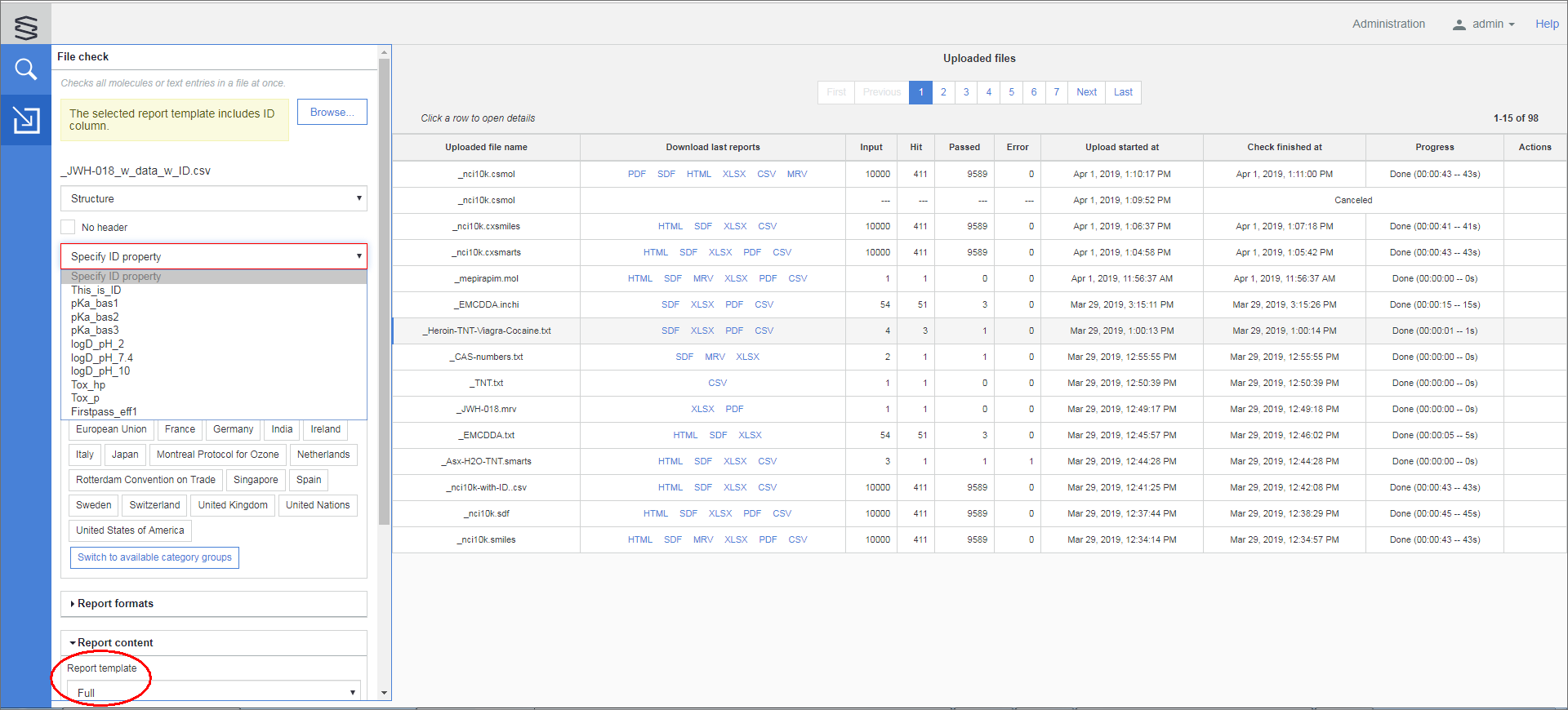
If the selected Report template contains the ID field and the file contains properties of the structures then the user is forced to select a property as the ID field.
The Check button is inactive until the ID field is not selected.
Content scope
For the content scope of the report(s) you can choose from the following possibilities:
- Controlled substances
- Highly similar structures
- Similar structures
- Non-controlled substances
- Errors
The default setting is Controlled structures and Errors.
Find more information Similarity categories
Notes (optional)
Entering data in this field is optional. You can put here some details about the above uploaded file. This information will be displayed only in the Summary table.
Date of regulations
Here you can pick a date in the past in order to execute the compliance checking according to the regulations valid at the selected date.
The default date is the current date.
Executing a File check
Check
Clicking on the Check button the file upload popup will be displayed. After the file upload is finished the popup is closed and the started File check will appear in the first row of the Uploaded files table. The check of the uploaded file will be started automatically and can be monitored in that row. The results of the ongoing check are displayed in the Input , Hit , Passed , Error cells and a progress bar (%).
File check can be stopped by clicking the " Cancel this job " in the Actions cell.
The progress of the ongoing file check can be monitored in the drop-down : Check execution time , Pending fragments and Finished fragments data show the progress and Input count , Hit count , Non-hit count and Error count show the interim results.
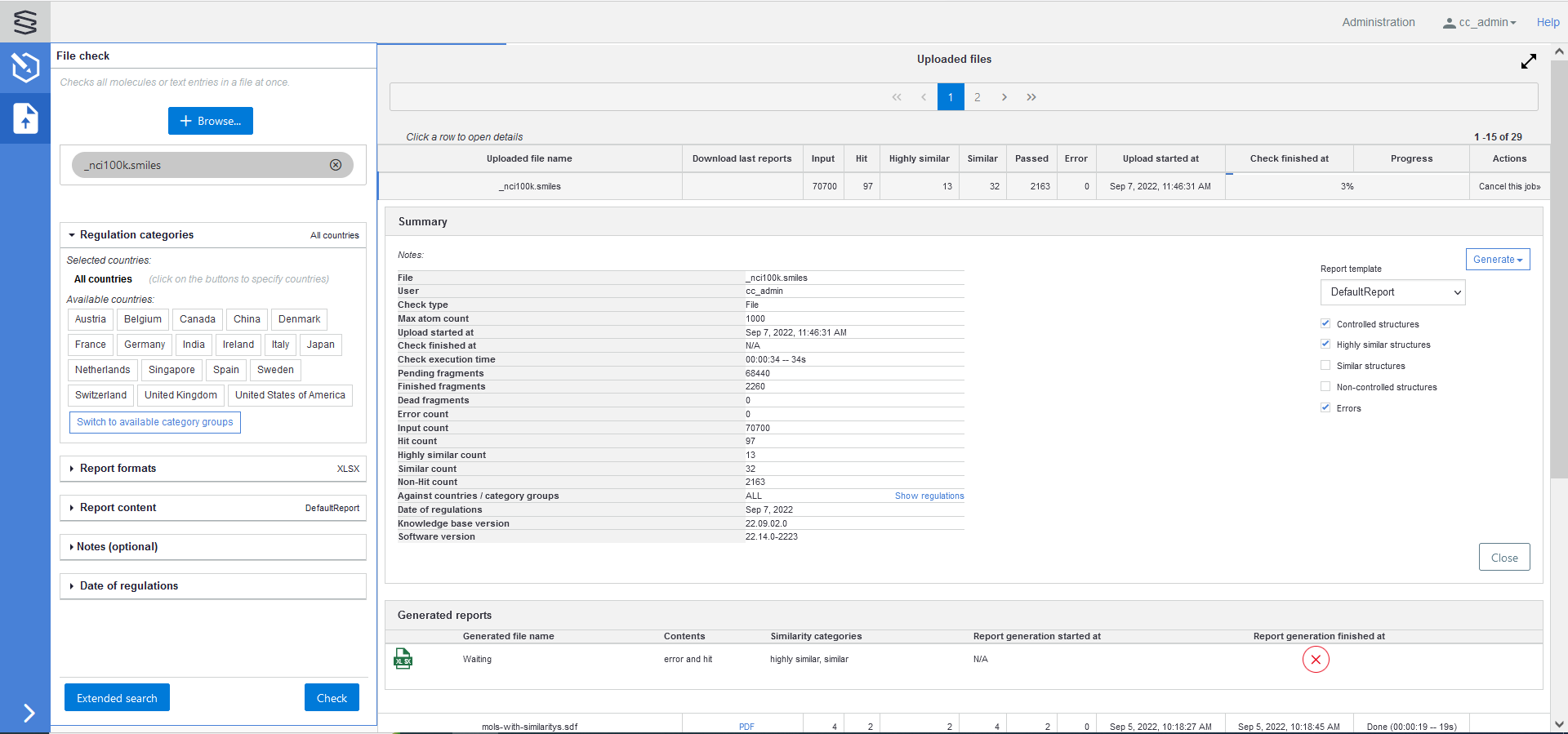
When the check is finished the Check finished at cell will be filled and the Progress cell will change to Done - showing the time that was required for the checking process and the report generation process will be started.
The Check finished at and the Progress cells will show Canceled when the File check was interrupted by the user - clicking the Cancel this job - and will show Error when the File check fails due to e.g. a structure import error.
Clicking on a row of the Uploaded files table displays the Summary drop-down with the detailed results and the Generated reports table.
History of all executed File checks - made by the logged-in User - will be displayed in the Uploaded files table.
Extended search
If the first 10 lines of the uploaded file are not recognized as MRV, MOL, RXN., SDF, RDF, CML, SYBYL. MOL2, Gaussian Cube/Input or PDB format then the file is considered as a single-line file and the  button is displayed on the File check page.
button is displayed on the File check page.
This Extended search runs a special search on these single-line files.
Each line of the uploaded file will be the text input of this special check one by one.
E.g. the file is considered as a single-line file if the first 10 lines are recognized as SMILES, SMARTS, CXSMILES, CXSMARTS, sequence (peptide, DNA, RNA), IUPAC or traditional names ( CASRegistryNumber®) - or these cannot be recognized as chemical structures.
- If the text input can be converted to structure then a structure search is executed to each line.
- If the text cannot be converted to a structure (and does not match the CAS Registry Number® regexp) then a text search runs on all of the text fields except the CAS# field (Name, Synonyms, DEA#, GTIN#, PubChem#).
- If the text matches the CAS Registry Number®regexp then only the CAS# field is checked. This step is executed even if the CAS Registry Number®could be converted to structure.
File check error Mixed structure types (e.g. name and SMILES ) are not allowed in a file and result in an error. If a CSV file's structure column was specified incorrectly then it also results in an error.
In this case, " Error " will be displayed in the Progress cell and only the file Upload started cell will be filled out, the previous 4 cells will show the reason for the error, e.g. " Error during structure import ".
This " Error " row does not have a dropdown to show the Summary but moving the cursor over this row a tooltip is displayed with showing the line number of the first error.

Clicking on this " Error " row will display a popup with the same contents as the tooltip.

File check results
Uploaded files table
The Uploaded files table contains all file checking jobs the user has run. (15 rows per page are displayed.)
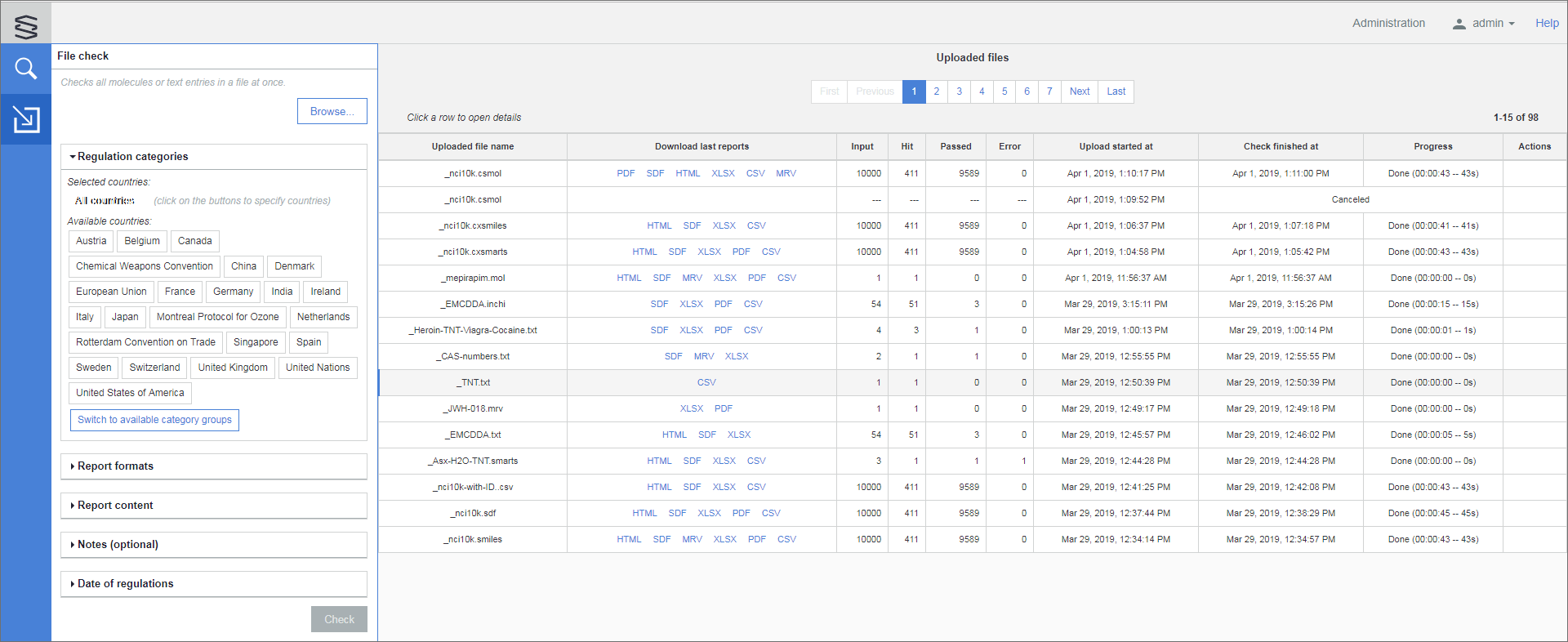
Each row contains the following fields:
| Field name | Explanation |
|---|---|
| Uploaded file name | name of the uploaded file |
| Download last reports | download links of the already generated reports |
| Input | count of input substances |
| Hit | count of controlled substances |
| Highly similar | count of highly similar substances* |
| Similar | count of similar substances* |
| Passed | count of non-controlled substances |
| Error | count of errors |
| Upload started at | date and time when the file upload was started |
| Check finished at | date and time when the file check was finished |
| Progress | % progress bar of the running job / Done (time of check) / Canceled / Error |
| Actions | the actually running job can be stopped if Cancel this job is visible here |
*shows result only if the check was performed against countries including the USA
In the Download last reports column the icons of the already generated PDF, HTML, SDF, MRV, XLSX and/or CSV reports are displayed. Click the corresponding document icon to download the file.
Clicking on a row displays the Summary table of the selected File check in a dropdown. (To close the dropdown click on the row again.)
Summary dropdown
The checking details of an uploaded file are displayed in the Summary dropdown which can be opened by clicking on a row in the Uploaded files table.
At the top of the Summary table, the Notes field is shown that was entered when the file to be checked was uploaded.
| Field name | Explanation |
|---|---|
| File | filename of the uploaded file |
| User | logged in user's ID |
| Check type | "File" or "Extended" |
| Upload started | date and time when the file upload was started |
| Max atom count | filters out molecules having more explicit atoms than this |
| Check finished | date and time when the checking was finished |
| Check execution time | difference between Upload started and Check finished |
| Error count | count of erroneous substances |
| Input count | count of input substances |
| Hit count | count of controlled substances |
| Highly similar | count of highly similar substances* |
| Similar | count of similar substances* |
| Non-hit count | count of non-controlled substances |
| Against countries/category groups | categories or category groups the check was run against |
| Date of regulations | selected date of regulations for the check |
| Knowledge base version | version of the knowledge base at the check |
| Software version | version of the software at the check |
*shows result only if the check was performed against countries including the USA
File check reports
Generating new reports
New reports of an earlier finished File check can be generated from the Summary drop-down by selecting a Report template from the dropdown list and the report content by selecting the relevant check boxes:
- Controlled substances
- Highly similar structures
- Similar structures
- Non-controlled substances
- Errors
Clicking on the Generate button the desired ** Report format** can be selected from the drop-down: HTML , PDF , SDF , MRV , XLSX or CSV .
After the selection of the **Report format, ** the report generation will start and will be listed in the Generated reports table.
The ongoing ( Waiting and/or Started ) report generation can be canceled by clicking the Kill report generation button.
Report types
The Generated reports table lists all reports of the selected File check that were already generated and the process of the ongoing report generation.
| All previously created reports are stored and can be downloaded later.
|
Field name | Explanation |
|---|---|---|
| Generated filename | the auto-generated filename will have the 'OriginalFilename_jobID.ext' format | |
| Contents | content of the report (hit only, error, not controlled) | |
| Similarity categories | similarity content of the report (highly similar, similar) | |
| Report generation started at | date and time when the report generation was started | |
| Report generation finished at | date and time when the report generation was finished |
The 'OriginalFilename' should have only the following valid characters: a-z, A-Z, 0-9, ., _, -
Other characters (and spaces) will be replaced with "_" in the auto-generated filename.
The Contents field shows the different selection of the Controlled structures/ Non-controlled structures / Errors checkboxes. The Similarity categories field shows the different selection of the Highly similar stuctures/ Similar structures checkboxes.